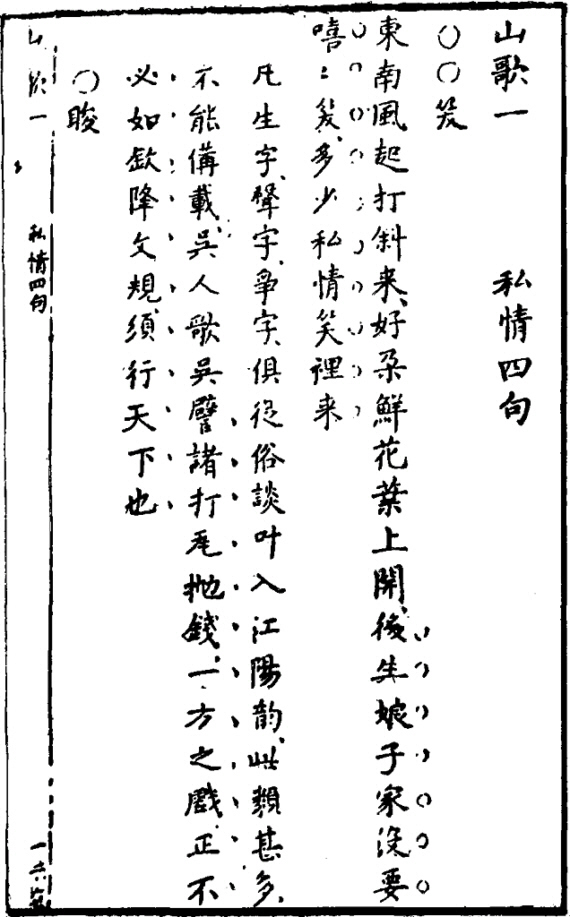Chapter 32 Chapter 6 Local Music Varieties Competing for Glory
This song appeared in the Song Dynasty, was sung in the Ming and Qing Dynasties, and is now known as "The Moon Bends on Kyushu". I don't know how many people were moved by its euphemistic and sad tone and humane content!Ming Yesheng's "Shuidong Diary" recorded the folk life in Jiangsu and Zhejiang, saying: "Wu people often sing songs to amuse themselves when they work on farming or boat trips.It can be seen that this minor tune known as "Folk Song" has developed into a well-known and sung song in Ming and Qing Dynasties.The titles of Ming and Qing minor tunes, folk songs, Shidiao, slang tunes, and small songs are often interchangeable, and sometimes they are also generally called "vulgar tunes".That is to say, the content of such songs mostly reflects folk and secular life and is popular and easy to sing, so they are very popular among urban and rural people.
Minor folk songs in Ming and Qing Dynasties are the direct inheritance and development of Song and Yuan ci-tune ditties. The richness of the tunes, the complexity of the content, and the wide spread far exceed the same type of folk songs in the Song and Yuan dynasties.According to the statistics of the names of Ming and Qing folk tunes listed in some historical materials compiled by Yang Yinliu, there are 31 songs in the Ming Dynasty, such as "Suo Nanzhi", "Shanpo Sheep", and "Dazaogan"; There are 208 pieces including Parasitic Grass, Silver Nymph, Cut Indigo Flower, Aunt Wang, Man Jianghong, Flower Tune ("Jasmine") (Fig. 36). In fact, there are countless folk songs. , There are too many to remember, more than a hundred or a thousand.
Minor folk tunes of the Ming and Qing Dynasties have attracted the attention of many literati and scholars with their beautiful and melodious tunes and simple and implicit popular lyrics. They either collected records and compiled them into books and published them; imitated their forms and styles to compose lyrics and music; or expressed their appreciation Admiration shows the rare enthusiasm of literati and scholars in the past for folk tunes.Feng Menglong (1574-1646), a litterateur and dramatist in the late Ming Dynasty, edited the volume "Folk Songs" (Figure 37), and became the first literati to privately publish a special collection of folk folk songs.Qing writer Pu Songling (1640-1725 A.D.) compiled Liaozhai Slang Song Collection, which included more than 50 folk songs, some of which are still sung in Zibo, Shandong.Such as Spectrum Example 2 "Song of Tribulation · Yu'erang" (fragment).

Figure 36 "Flowers Tune" folk score
During the widespread dissemination of folk tunes in Ming and Qing Dynasties, it had a profound impact on rap music genres and local opera music arias. Some rap tunes and local opera genres often absorbed folk folk tune minors to enrich and develop their own genres and operas. music vocals.For example, the minor tune "Jianjianhua", formerly known as "Jiandianhua", was widely circulated all over the country in the late Ming and early Qing Dynasties. In the collection of popular songs, it evolved into a minor tune called "Flying a Kite" in Sichuan Qingyin;Another example is the minor tune "Silver New Silk", which began to spread all over the country in the Ming Dynasty. "Home" is its typical relic, see example 3 for its music score.

Figure 37 "Folk Song" book shadow (clear)
Tribulation Song Yu'erang
1=G
Shandong Liuchuan
Ren Kyun, Chuan Kun Ji
 It is also this minor tune, and at the same time, it is used as a common tune to fill in lyrics and sing in rap and opera genres such as Single String, Sichuan Qingyin, Shanghai Opera, Xi Opera, etc.
visiting relatives
Hebei folk songs
It is also this minor tune, and at the same time, it is used as a common tune to fill in lyrics and sing in rap and opera genres such as Single String, Sichuan Qingyin, Shanghai Opera, Xi Opera, etc.
visiting relatives
Hebei folk songs
 The reason why the folk tunes of the Ming and Qing Dynasties have such a deep mass base and extensive artistic influence is not only that the times endowed it with a specific social, economic and cultural soil that is convenient for development, but also because it has some artistic characteristics that are easy to accept by the general public, that is, it Popularity in ideological content; simplicity in form and structure; plasticity in music form and entertainment in artistic function.
The reason why the folk tunes of the Ming and Qing Dynasties have such a deep mass base and extensive artistic influence is not only that the times endowed it with a specific social, economic and cultural soil that is convenient for development, but also because it has some artistic characteristics that are easy to accept by the general public, that is, it Popularity in ideological content; simplicity in form and structure; plasticity in music form and entertainment in artistic function.

Figure 36 "Flowers Tune" folk score

Figure 37 "Folk Song" book shadow (clear)


